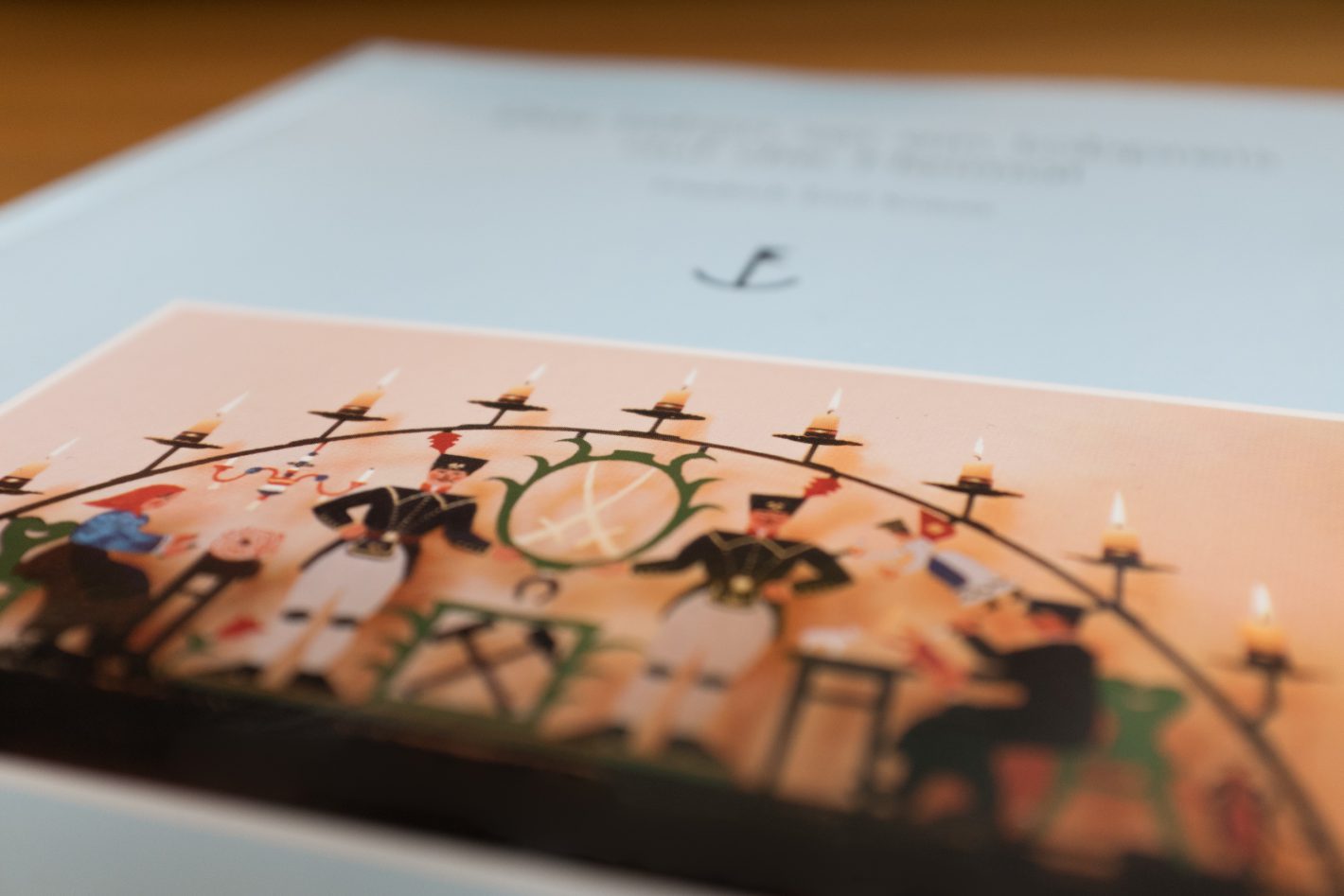I never knew my great-grandfather Friedrich Emil Krauß. I was born one year after his death. After the Second World War, he had to leave his homeland forever. My father is one of his grandsons. His family left Saxony in 1955 and found a new home in Baden-Baden. I grew up in the region of Lake Constance and Villingen-Schwenningen. Since 1998 I have lived in Dresden.
When another great-grandfather of mine was buried in 1986, I asked as a little boy: “Were there actually people before the great-grandparents? “. At that time, Germany was divided. The family history was in the GDR at that time, while the family was now living in the Federal Republic of Germany. It was an encouragement for my grandparents to write down their history. Although Friedrich Emil Krauß had his family history documented, that of his son-in-law, my grandfather, was missing. My grandfather, as an engineer, brought the compiled information on his large drawing board, which stood in his study, as a family tree with ink on parchment in years of work. When I visited during the vacations, he liked to show me what he had found out on the genealogical chart. He documented the extensive research with the computer and wrote books.
Working with the new technology was not easy for my grandfather. But the younger generations helped him again and again. Naively, we got along with the technology, and he noted down the process as we went along. Today, this is called “paired programming.” My grandmother kept her distance from technology and dictated her texts to him.
Friedrich Emil Krauß at the time of the Second World War
When the church records gave nothing more for the family tree, the biography of his father-in-law Friedrich Emil Krauß came to the foreground. He was very well known in his hometown Schwarzenberg in the Erzgebirge as a factory owner of the Krausswerke. Even after the war, washing machines continued to be manufactured at the VEB Waschgerätewerk Schwarzenberg, and after the fall of the Berlin Wall, the first CFC-free refrigerator was produced here. To commemorate his 100th birthday, my grandparents compiled a book about him. I still remember how, during a visit, I edited the cover picture on the computer so that all the candles on the Schwibbogen burned with the same brightness (see photo above).
As a child, I learned about the family history in fragments. The time of the Second World War was left out. When the evening news mentioned the party PDS (Party of Democratic Socialism), my grandfather emotionally railed on “the Reds” and my grandmother sat quietly in the background. “The Reds” had, in his view, burned down the wooden house, the modern home of the Krauß family, and destroyed everything. I did not know a factual discussion of the time. But on the photos of the Krauss works, swastikas appeared.
When I began my studies of mechanical engineering at the Technical University of Dresden in 1998, I came across the list of honorary doctors of the faculty. Among them was one Friedrich Emil Krauß. When I asked if this was my great-grandfather, my grandfather confirmed it and immediately sent me a copy of the certificate. Strangely, I held this in my hands. The stamp with a swastika and the date 29.03.1945 let me ask: What role did he play during the Nazi era? Was he a party member? Was he actively involved in racist politics? I never asked my grandparents these questions.
Treatment of Eastern Workers
For years I lived with the uncertainty of how my ancestors had acted during that time, but it was also distant because I was not confronted with it in everyday life. In 2018, when I took a trip to Schwarzenberg with my siblings, the obscurity began disappearing. In a café, we received a print of the article: Friedrich Emil Krauß (1895-1977) – Ein Unternehmer aus dem Erzgebirge (Friedrich Emil Krauß (1895-1977) – An Entrepreneur from the Ore Mountains), written by Lenore Lobeck. Objectively and differentiated I received answers to the questions. On the one hand, it shows how he ran a showcase company during the Second World War and received representatives of politics, but also how he cared for his workers, whether Schwarzenbergers for generations or forced laborers of the Nazi regime.
This humane treatment of his fellow man was recognized by the Saxon State Directorate when it examined his actions during the Second World War last year as part of a claim for compensation by his daughters, who have now passed away. Although no exculpatory documents for him could be found in the archives of the town of Schwarzenberg, the federal government, and other sources available today – it would have been to his disadvantage at that time – but some were found in a folder prepared for this purpose by my grandparents and in the extensive research of Lenore Lobeck.
It came to a positive decision of the Saxony State Directorate; in particular, his handling of the Eastern workers was convincing. He personally cared not only for their human and supply welfare but also provided them with musical instruments. Ultimately, they gave him a farewell serenade at the train station. As the responsible desk officer of the Saxony State Directorate informed, such a positive story rarely happens. Most people at that time did not use their margins for humane treatment.
It was not natural to do the humane thing and use the possibilities to treat fellow human beings with dignity. At this point, it should not be forgotten that Friedrich Emil Krauß had a well-running business during the Nazi regime and also produced armaments. He was in contact with the state level, especially to strengthen the folk culture in the homeland. He did what one did in that position at that time and was thus also part of the Nazi propaganda apparatus.
The heritage of Friedrich Emil Krauß
I am pleased that light also shines when looking into the dark times. Starting in 1945, Friedrich Emil Krauß spent 9 years in prison – under the most challenging circumstances. The support from his hometown and the memory of the good times must have enabled him to survive these difficult times. Even more important for him, however, may have been the dignified treatment of his fellow human beings.
My grandmother wrote about him in her book Das Leben sei ein Lobpreis auf die Heimat: “During the years of his imprisonment, a benevolent Russian officer said to him that he had the misfortune to have been a rich man. He said that external wealth was to blame for his internment, but his internal wealth helped him to get through this difficult time.” (translated by the author)
If I look today at the subjects he was engaged with, it was not just the business enterprise; social and cultural matters played a major role. These are becoming increasingly important today. The economic heritage of Friedrich Emil Krauß is no longer significant due to the radical changes of the past, but the other treasures remain essential and are not the sole property of his direct descendants. He did not only do what one had to do – he stepped out of the “they” and became visible in his uniqueness.
One does or creates by oneself
Heidegger writes in Being and Time about the “they” that it unobtrusively and undetectably unfolds its dictatorship. In this intangible form it can take responsibility, since no one is it and thus no one has to answer for anything. The impersonal equalization and the average is opposed by the uniqueness of every human being. And so Heidegger writes further about being human in our world: “If Dasein discovers the world in its own way and brings it close, if it discloses to itself its own authentic Being, then this discovery of the ‘world’ and this disclosure of Dasein are always accomplished as a clearing away of concealments and obscurities, as a breaking up of the disguises with which Dasein bars its own way.” For Hannah Arendt, this is essential for togetherness, which is not for each other.
Especially in today’s world, hygiene is important, a topic that the Krausswerke served with the beginning of bathtub and washing machine production. The love of the homeland and the willingness to shape it were other key themes in the work of Friedrich Emil Krauss. Even today, the candle arch designed by Paula Jordan can be seen illuminated in the windows at Christmas time. The motif had been selected in a competition he initiated, but he had replaced the swastika with the Meissen swords. His humane treatment of his fellow human beings, especially the forced laborers, is positively recognized today and, in view of the treatment of people fleeing to us, is still not a matter of routine. With his early separation from his wife, he also passed on an important task to later generations. I am grateful for the fact that my parents and grandparents consequently live family with each other.

